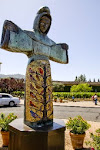Have you ever thought some of the Windows 10 sign-in images
would make great desktop wallpapers? The problem is you have no idea where to
find them and how to do it.
Cheer up and get busy. Microsoft adds these wallpapers at
random and removes them randomly as well.
I
mages are stored in the folder below:
Desktop\Your Name\AppData\Local\Packages\
Microsoft.Windows.ContentDeliveryManager_cw5n1h2txyewy\LocalState\Assets
Note that “%userprofile%” is what the writer calls Desktop/ your_name.
You must complete three tasks before you can truly use them
as wallpaper.
Locating the Images
|
Step
|
Action
|
|
1
|
Open Windows File Explorer.
|
|
TIP
|
Hold down the Windows
key and then press E.
|
|
2
|
Click the down arrow by Desktop and then select your user name.
|
|
3
|
Click to follow this path: AppData\Local\Packages\ Microsoft.Windows.ContentDeliveryManager_cw5n1h2txyewy\LocalState\Assets
|
|
Result
|
You are presented with a list of filenames, none of which
make any sense.
|
|
4
|
Click inside the list of file names.
|
|
5
|
Press Ctrl+A
and then press Ctrl+C to select
all files and then copy them.
|
|
6
|
Proceed to Storing, Sorting and Renaming Images.
|
Storing, Sorting and Renaming Images
|
Step
|
Action
|
||||||
|
1
|
Right-click on an open area on your desktop.
|
||||||
|
2
|
Select New >
Folder.
|
||||||
|
3
|
Name the folder Wallpaper
Images and then double-click
to open it.
|
||||||
|
4
|
Press Ctrl+V to
paste the images into the new folder.
|
||||||
|
5
|
Click the View tab and then select Details.
|
||||||
|
Click the Size
column heading to sort the images by size.
|
|||||||
|
7
|
To make the Size
heading visible, right click to the right of any current heading and then
click More.
|
||||||
|
8
|
Scroll through the list to locate Size and then click OK.
|
||||||
|
Result
|
The Size
heading appears.
|
||||||
|
Alternate
|
When updating an existing list of image files, click the Date Modified heading instead of Size and then follow Steps 6-8. Only copy the new image files.
|
||||||
|
Click the Size
heading and then scroll down to review the file sizes.
|
|||||||
|
TIP
|
Generally anything less than 100 KB is not an image that
will work as a desktop background (i.e., wallpaper). Since you are working
from a copy of the original files, you can safely delete those that are too
small.
|
||||||
|
Rename the files temporarily by right-clicking the
filename and then selecting Rename.
|
|||||||
|
11
|
Give the file a name that makes sense to you and then
input “.jpg” (Do not input the
quotation marks).
Example DSC02850 becomes glass building.jpg
|
||||||
|
VIP
|
Adding the “.jpg” tells Windows this is an image file so
it can display it.
|
||||||
|
12
|
Click the View tab and then select Extra large icons or Large Icons to see samples of each
photo.
|
||||||
|
13
|
Right-click any image you do not want and then select Delete to remove it.
|
||||||
|
14
|
Rename any image as desired. Refer to Step 10.
|
||||||
|
15
|
Proceed to Using as Wallpaper.
|
Using Images as Wallpaper
|
Step
|
Action
|
||||||||||||||
|
1
|
Open Windows File Explorer.
|
||||||||||||||
|
TIP
|
Hold down the Windows
key and then press E.
|
||||||||||||||
|
2
|
Click the Wallpaper
Images folder on your desktop and then press Ctrl+X to cut it.
|
||||||||||||||
|
3
|
Click the down arrow by Desktop and then select your user name.
|
||||||||||||||
|
4
|
Double-click the Pictures
folder.
|
||||||||||||||
|
5
|
Click inside the Pictures folder and then press Ctrl+V to paste the Wallpaper Images
folder inside Pictures.
|
||||||||||||||
|
6
|
Right-click on
your Desktop and then select Personalize.
|
||||||||||||||
|
7
|
After the Settings
window appears, Background displays the current background. Click the Background drop-down menu and then
select Picture or Slideshow.
|
||||||||||||||
|
8
|
Click Browse
and then navigate to the folder holding your images.
Example: User>Pictures>Wallpaper Images.
|
||||||||||||||
|
9
|
Ensure the Folder
field displays the correct name and then click Choose this folder.
|
||||||||||||||
|
10
|
Click the Change
picture every drop-down menu and then select the appropriate time.
Example: 30 minutes.
|
||||||||||||||
|
11
|
Determine the image order.
|
||||||||||||||
|
12
|
Choose a fit.
|
||||||||||||||
|
13
|
The process is complete.
Note: Free photos—primarily of San Francisco and Northern
California but also including Yellowstone National Park—are available on my Pinterest Page.
|













